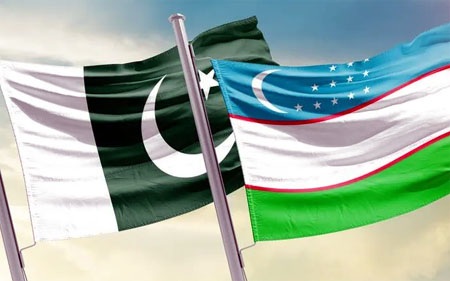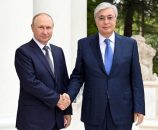Dr. Mehmood Ul Hassan
Pakistan and Uzbekistan are the gateways of greater regional connectivity for South Asia and Center Asia Regions. Both have shortest and easiest means of connectivity which would definitely transform the regional economies in the days to come. Moreover, trilateral trans-regional railway project among Pakistan, Afghanistan and Uzbekistan have further brightened the chances of greater regional connectivity between two regions.
Since currently Uzbekistan holds the chairmanship of SCO that is why lots of activities are being carried out in the country. In this connection, most recently on 12 May 2022, Uzbekistan chaired the 9th meeting of SCO Ministers of Transport, which was held in the hybrid format in Khiva.
SCO Secretary-General Zhang Ming pointed out in his opening remarks that the Covid-9 pandemic and increasing international tensions had certain spillover repercussions for all the economies and countries including SCO states, notably their transport sectors. He termed integrated transport system crucial for promoting trade and economic cooperation and ties between people and markets.
During the said meeting the agenda of SCO Transportation Connectivity was thoroughly discussed for boosting cooperation within the SCO framework based on the sector’s digitalisation. Priority attention was paid to measures being taken in the SCO countries to prevent the spread of COVID-19 on transport.
All the ministers supported the draft strategy on expanding connectivity and establishing cost-effective economic and transport corridors.
Being chairmanship of the SCO summit Uzbekistan suggested further strengthening of the mutually beneficial cooperation in the field of transport, developing and diversifying transport corridors, and effectively using existing opportunities in this area.
Even President of Uzbekistan Shavkat Mirziyoyev’s vision of greater regional connectivity between Central Asia and South Asia supported integrated transport system in the SCO member states. The development of regional transport and transit potential is one of the important factors for the sustainable economic growth of the SCO member states due to which forming a unified approach to creating a holistic and integrated transport system, the development of trade and economic relations with the introduction of modern digital technologies should be mantra of every member states of the SCO.
During the meeting all the participants supported the draft Concept of Cooperation between the SCO Member States on the Development of Interconnection and the Creation of Efficient Transport Corridors, prepared by the Uzbekistan government. It was decided to form a special transport working group for deepening cooperation in the field of transport.
Uzbekistan is playing a key role in ensuring peace and tranquility in the SCO space. Uzbekistan’s numerous initiatives and meaningful proposals are helping to expand the agenda of meetings of the SCO countries’ heads of ministries and agencies and improve the organisation’s international standing.
During Uzbekistan’s chairmanship of the SCO it has been steadily strengthening cooperation in the spheres of regional stability, transport connectivity, innovations and high technology, and cultural and people-to-people diplomacy. Notably, Uzbekistan’s SCO chairmanship has stipulated over 80 events to prepare the main event of the year, a meeting of the SCO Heads of State Council, scheduled to take place in Samarkand on 15-16 September 2022.
Now let us briefly discuss about the strategic importance of transport system in the overall socio-economic development. It has been one of the key drivers of socioeconomic development in numerous countries including China, Vietnam, Thailand, Singapore, Indonesia, Norway, and Sweden. Efficient transport allows common people to access jobs, markets, social interaction, education, and other important services, enabling people to rise out of poverty and overcome social exclusion. Transport adds value to goods and services brought to markets, links rural areas to cities and global supply chains, driving economic development and SCO member countries do not have any exception.
On its part, the government of Pakistan has invested large amounts of human and financial resources into the development of the transport sector through the China Pakistan Economic Corridors (CPEC) program, the Central Asia Regional Economic Cooperation (CAREC) program and other initiatives. Pakistan has been applying the Cluster Trading System (CTS), Turks Trading System (TTS) and last but not least, the Transport Internationaux Routier (TIR) to form a dynamic and diversified transport system between Uzbekistan.
Pakistan needs to support these large investments with a cohesive policy and planning framework to transform the transport sector into a modern, sustainable and effective one, helping businesses to grow, empowering the creation of new industries and supporting the creation of quality jobs.
This National Transport Policy of Pakistan 2018 reflects its aim to create a world class transport sector. The Policy provides a vision, governance principles, policy objectives, contributions for each subsector, and the implementation arrangements.
On the other hand, transport and infrastructure play an important role in Uzbekistan’s economy. Implementation of the open economic policy requires the penetration of new markets. Uzbekistan aims to diversify its exports. Besides traditional markets such as Central Asia and Russia, the country increases its supplies to China, the countries of Europe, and Turkey.
In 2020, the volume of international transportation of goods of Uzbekistan amounted to 47.1 million tons, of which 13.3 and 24.7 million tons were exports and imports, respectively.
The volume of transit transportation equaled 9.1 million tons, increasing by 15.3 percent. Rail and road transport are the two leading transport modes for trade.
Over the past decade, the government of Uzbekistan has made substantial progress in improving international corridors. Its main investment priorities up to 2030 include reconstruction and construction of another 8000 kilometre (km) of internationally important public roads and developing new international corridors. The country plans to develop north, northwest, south, southwest, and east corridors, which will allow Uzbekistan to access the markets of the Eurasian Economic Union countries, the European countries, Iran, Turkey, Afghanistan, Pakistan, India, and China.
Uzbekistan’s Transport Strategy 2035 defines the Middle Corridor as one of the key priorities of Uzbekistan.
According to prominent economist sustained socioeconomic development depends on the effective operation of every country’s transport system and its interconnection with neighboring countries.
In this connection, the SCO member states have been working to create a multilateral transport system. The Agreement on International Road Transportation Facilitation, which was signed in Dushanbe of Tajikistan on Sept. 12, 2014, is a breakthrough in the spheres of economy and transport.
It opened more than 15,000 kilometers of the Asian Highway routes for transport operation and services, with the longest route stretching more than 9,000 km from Saint Petersburg, Russia, to Lianyungang, China. It has also developed landlocked Central Asia’s access to sea by road through China and Russia.
Within the framework of the Agreement, six new international road transport routes across the territory of all six then-SCO member countries were planned from 2017 to 2020.
Routes of the Asian Highway (AH) network, such as AH4, AH5 and AH7, European route E40 and the New Eurasian Land Bridge are also part of the interconnectivity between the SCO members.
The Asian Highway network is a regional transport cooperation initiative in a bid to enhance the efficiency and development of the road infrastructure in Asia, supporting the development of Euro-Asia transport linkages and improving connectivity for landlocked countries.
The New Eurasian Land Bridge (NELB), also called the Second Eurasian Continental Bridge, is an international passageway linking the Pacific and the Atlantic, consisting of a series of rails running about 10,800 kilometers from China’s coastal cities of Lianyungang and Rizhao to Holland’s Rotterdam and Belgium’s Antwerp.
The NELB is distinct from the Siberian Land Bridge which goes from Russia’s eastern port of Vladivostok through Siberia to Moscow and onward to West European countries.
To conclude, Uzbekistan has launched the construction of $5 billion Trans-Afghan Railway Line project to access Pakistan’s major seaports, which will boost regional connectivity and trilateral trade. It will enhance connectivity through seaports, increase trade, and save money and time.
Due to Central Asia’s distance from the open sea, railways have a pivotal role to play in the economic planning of these states, especially Uzbekistan which is working on these proposals for years.
On February 2, 2022, these three countries in Tashkent agreed to a roadmap for the construction of 600-kilometre-long rail project connecting Pakistan, Uzbekistan, and Afghanistan (Mazar-i-Sharif-Kabul-Peshawar railroad).
It is the most economical and shortest route connecting Central Asia with Pakistani ports of Karachi, Gwadar, and Qasim. It would be game changer for the region’s future.
Interestingly, geography of Pakistan provides the shortest, most economical, and easiest land route for Central Asia to access Arabian Sea. Afghanistan is termed the ‘heart of Asia. It connects different regions, mainly Central Asia, via Tajikistan, Turkmenistan, Uzbekistan, South Asia via Pakistan, and the Middle East, via Iran.
China Pakistan Economic Corridor (CPEC)’s mega project of ML-I would be considered to connect with trilateral trans-regional railway project in the days to come which would be a value addition for its early completion. Moreover, CPEC greater connectivity with Afghanistan and other Central Asia states via BRI would further consolidate chances of greater regional connectivity.
Connectivity has become a defining feature of the modern economy. Central Asia needs to develop southern trade links to complement existing north, east, and west routes.
For the time being, available means of cargo transportation, cluster trading and TIR to Uzbekistan should be streamlined and systemized. Since both countries are members of the SCO so common projects may also be initiated to further increase regional connectivity. Commercial cargos may be out of the box idea for further strengthening of bilateral trade and of course regional connectivity.
Hopefully, SCO member countries may play a key role in global and regional economic and trade integration. It may be combined with the potential markets of the EU and Eurasia for trading by merging South Asia and Central Asia. The SCO may also be useful to ASEAN and the Middle East. Thus SCO has strategic importance.
Obviously, Pakistan and Uzbekistan have a very important role to play an important role in the further strengthening of trade and socio-economic integration to the SCO member countries. Joint efforts should be initiated to further integrate road and rail links in bilateral and transit trade in SCO countries. Logistics and transportation sector needs to be strengthened as soon as possible.
I suggest that sea routes need to be opened for trade among SCO member states. Pakistan and Uzbekistan have already signed an agreement to enhance bilateral trade through Karachi and Gwadar ports. A connectivity terminal will be built in the city of Tirmuz in Uzbekistan, which will connect Pakistan with Central Asian countries including Euroasain and European and maritime markets.
(The author is Director:
The Center for South Asia & International Studies (CSAIS) Islamabad Regional Expert: Uzbekistan & CIS)





